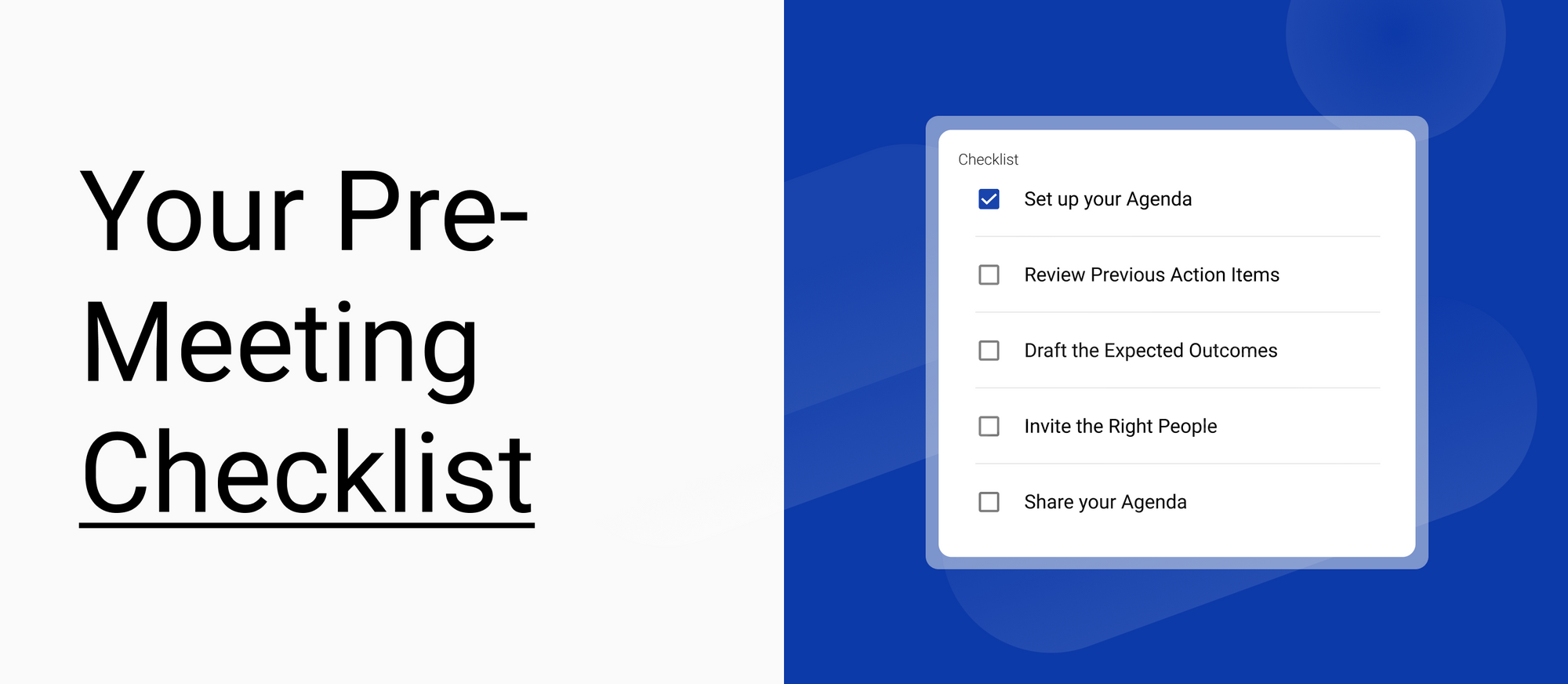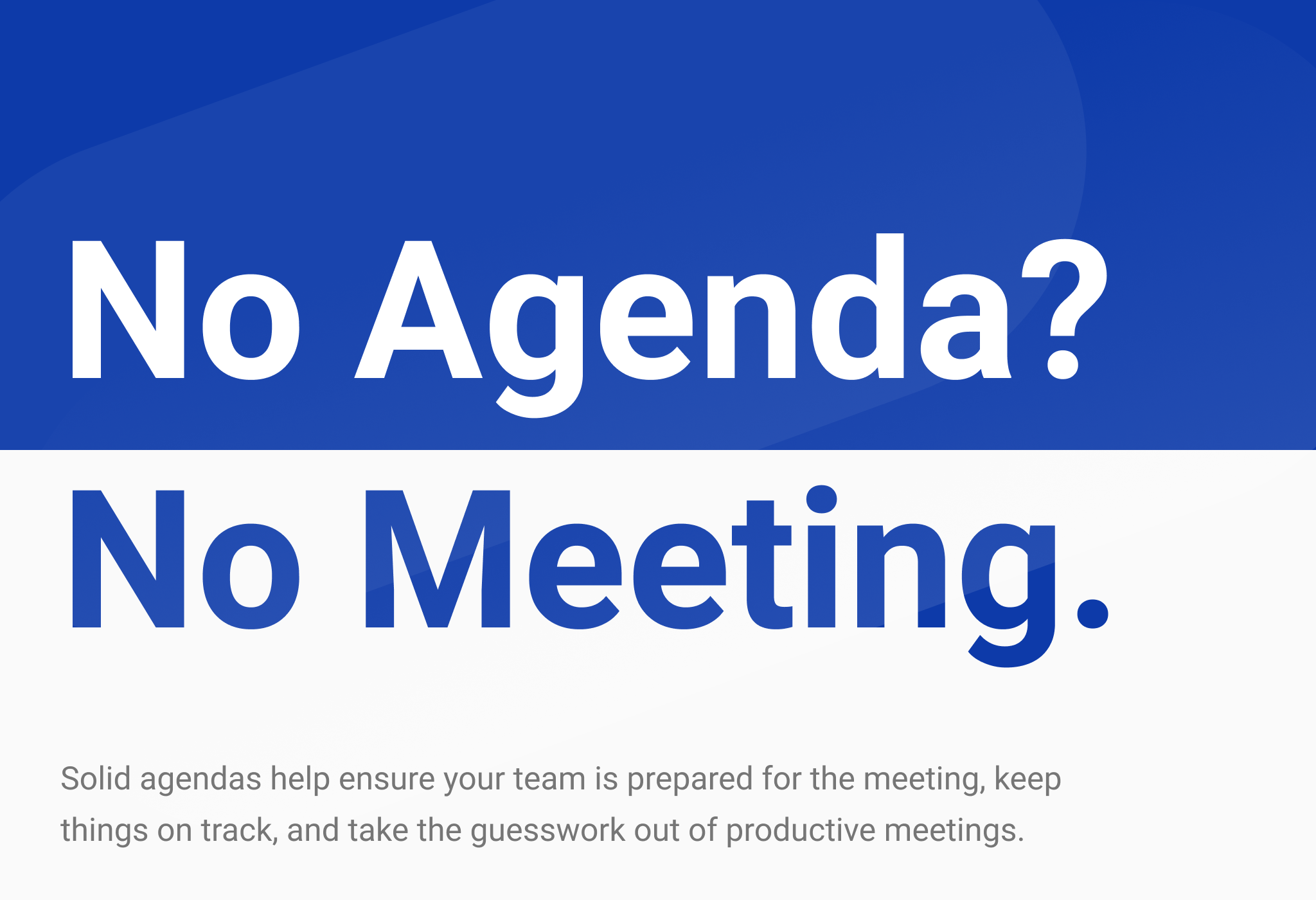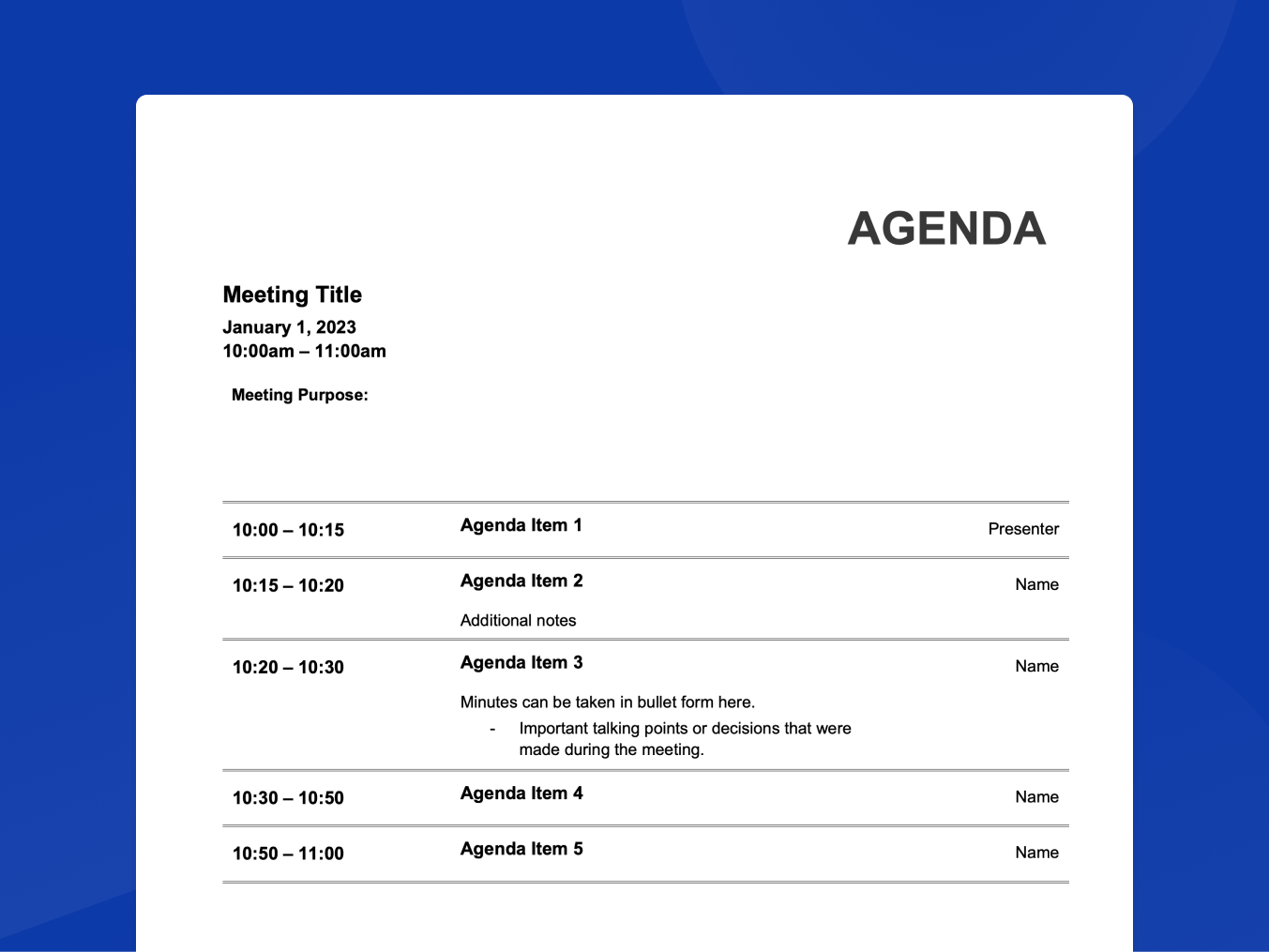Your Pre-Meeting Checklist (Free Templates)
What does it take to be fully prepared for any meeting? We go over 5 key steps with some helpful free templates along the way!

Coming to meetings without preparing in advance is such a common occurrence that we barely bat an eye anymore when it happens. And yet, we’ve all felt the difference between meetings with a set agenda that run smoothly through all the items and produce a concrete list of action items, and those that meander around to topics as attendees recall them.
Though the margin of productivity between those two kinds of meetings is significant, the amount of time it takes to prepare for any given meeting and transform it from a useless one to a useful one is only a few minutes. We’ve talked about quick meeting preparation before, but here we’ll look at the major pillars of meeting preparation and how you can optimize your workflow to save you hours every week.
Step 1: The Agenda

Your meeting agenda is easily the most important step in your meeting preparation. Think back to your most recent team meeting and see if you can answer the following five questions:
- Did you come prepared with an agenda, or review an agenda sent out by someone else in advance?
- If there was an agenda, how did it affect the meeting’s structure?
- How long did it take to create or review the agenda?
- If there was no agenda, how do you think an agenda would have altered the meeting?
- Would the added structure of a concrete agenda be useful or detrimental?
It is rare to come into a meeting having no idea what to expect. Even with disorganized meetings, you can usually guess roughly the topics of discussion based on previous meetings or by knowing who scheduled it. This can trick attendees into thinking that everyone is on the same page even when no agenda has been sent out.
The issues arise when not everyone present at the meeting has the same idea about what should be covered. If there are conflicting opinions on what needs to be discussed, your meeting might hop from topic to topic or you might run overtime trying to cover everything. Alternatively, you might find that you’ve spent the majority of your time on the items your coworkers wanted to discuss before you spoke up and mentioned the topics you were interested in addressing — leaving too little time to give your topics the consideration they needed.
We cover time-boxing at length in a different article, but before your next meeting, spend two or three minutes jotting down what you hope to cover during the meeting. Here’s a simple agenda template that you might use for your next meeting:

Microsoft Work Meeting Template:
Microsoft Excel Meeting Template:
Google Docs Meeting Template: Direct Link
This template is super simple and quick to complete, allowing you to spend more time focusing on your work while keeping your next meeting on track. However, if you want to make the most of your time preparing for meetings, there are a few more elements that you need to think about before considering your meeting prep done!
We also have a whole set of free meeting templates for all kinds of meetings that you can access here: https://knowtworthy.com/templates/
Step 2: Review Previous Action Items
As we discussed above, if you have a meeting on your calendar, even if there isn’t an agenda at the moment, you might have a rough idea about what you’ll be talking about regardless. Previous action items are a common way to guess what likely happened since the last meeting and thus what should be mentioned this time around.
If any tasks were assigned to you last time, then you probably recorded them in your personal productivity system and can discuss updates next time around. However, do you know the status of any of the tasks that were assigned to others during a previous meeting? Keeping track of action items, even those that you aren’t responsible for can provide you with a solid baseline from which to write your agenda for the next meeting.
For example, a common but overly simple agenda item that people write is something like “Review progress from last week”. While this is certainly better than no agenda after all, there really isn’t much information on what actually has to be discussed, or how long that discussion will take. Is there only one item that has any progress? Will this whole update just take a couple of minutes? Or were there a substantial number of action items that need to be reviewed one by one for comments?
Now, if instead, you have the list of action items from a previous meeting, you can easily digest this general agenda item into a few more specific ones and roughly guess how long each will take.
For instance:
- Review progress from last week
Can now become something like:
- Review new figures that Ben prepared (5 minutes)
- Discuss Anne’s new marketing proofs (10 minutes)
- Decide which vendor to go with based on Peter’s info (15 minutes)
And just like that, the first 30 minutes of your next meeting is planned out and you’ll have a good sense of what to expect and what the outcomes might be - which flows into the next step of preparation.
Step 3: Draft the Expected Outcomes
Whereas your agenda will state what it is you’ll be spending time on during your meeting, a crucial aspect of your preparation is what you hope to accomplish during the meeting itself. You don’t have to have specifics nailed down at this point — after all, if you already knew the meeting’s outcome why meet at all? Instead, try to outline what it is you think should definitely be addressed and what feedback is important.
Going back to our example in Step 2, say that Ben’s figures will both provide helpful information to your team about current business performance, but will also eventually need to become public as well. You might quickly look over the new information and discuss how it impacts your business trajectory, but a second expected outcome is that you also think about whether or not they are polished enough to release publicly or if some reformatting should be done.
Once you have a few expected outcomes, you can add them under their relevant agenda items in the template that we shared above. Also, please note that if you aren’t sure about the expected outcomes for a particular agenda item, try to reach out to the person in charge of it before the meeting and see what they think! This is a great way to show initiative and ensure that your time estimates for each item are appropriate.
Step 4: Invite the right people
Next up is a quick and easy step, but one that you should think about a bit before every meeting. It is very easy to get caught up in the loop that everyone on your team should be present at certain project meetings, even when only a few members are directly involved in the current stage of the project.
Don’t forget that meetings are very costly and having everyone present “just in case” can hinder your team’s productivity overall. So, the next time you schedule a meeting, look over the agenda and see who the key players in that meeting are going to be. Furthermore, if possible, make sure that potential attendees know that they can decline the meeting if they don’t see themselves contributing meaningfully and their time would be better spent working.
Step 5: Share your agenda
Finally, we recommend you share your agenda with your colleagues before the meeting actually happens, to prevent any conflicts in what needs to be covered. We covered a few of the reasons why this is important above, but with how easy it is to share documents online, sending around your meeting agenda beforehand is a quick way to get valuable feedback.
One way to share your agendas quickly while keeping them collaborative is to use a shareable solution out of the box. We’ve already included a Google Drive meeting template above, but there’s also a free cloud-based solution to get you started: here. Simply click “Start a Meeting”, add your agenda, attach the link to your meeting’s calendar invite, and all of your other attendees will be able to collaboratively edit the agenda, meeting minutes, and action items.
That’s all for this post! If you’re interested in more meeting best practices to keep you on top of your workplace productivity, check out some of our other posts here.
